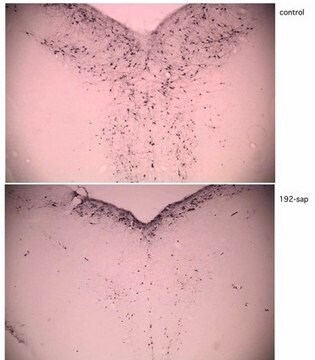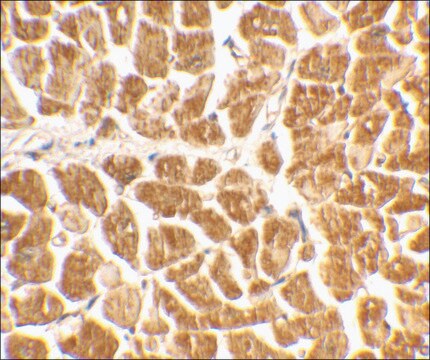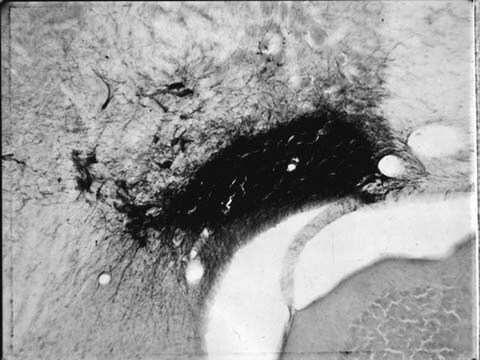MAB394
Anti-Dopamine β Hydroxylase-SAP Antibody, clone 4F10.2
clone 4F10.2, Chemicon®, from mouse
Zaloguj sięWyświetlanie cen organizacyjnych i kontraktowych
About This Item
Kod UNSPSC:
12352203
eCl@ss:
32160702
NACRES:
NA.41
Polecane produkty
pochodzenie biologiczne
mouse
Poziom jakości
białko sprzężone
saporin
rodzaj przeciwciała
primary antibodies
klon
4F10.2, monoclonal
reaktywność gatunkowa
rat
opakowanie
antibody small pack of 25 μg
producent / nazwa handlowa
Chemicon®
metody
immunolesioning: suitable
izotyp
IgG1
numer dostępu NCBI
numer dostępu UniProt
Warunki transportu
wet ice
docelowa modyfikacja potranslacyjna
unmodified
informacje o genach
rat ... Dbh(25699)
Powiązane kategorie
Specyficzność
Dopamine b-HydroxylaseDBH is a single gene product that exists as a cytosolic enzyme, as a membrane protein and is secreted into the circulation (Lewis & Asnani, 1992). Because of its residence time as a plasma membrane-bound protein, it is able to be used as a targeting agent for neurons. The target neurons include postganglionic sympathetic neurons and all noradrenergic and adrenergic neurons of the central nervous system. As such anti-DBH-SAP can be used for the production of acute peripheral autonomic failure in a model for the human disease. It can also be used for the analysis of the behavioral effects of noradrenergic or adrenergic ablation. When injected intraventricularly, noradrenergic neurons of the locus coeruleus are eliminated (Wiley & Lappi, 1994). The antibody and immunotoxin undergo retrograde transport.
Zastosowanie
Anti-Dopamine β Hydroxylase-SAP Antibody, clone 4F10.2 detects level of Dopamine β Hydroxylase & has been published & validated for use in 0.
Inne uwagi
Concentration: Please refer to the Certificate of Analysis for the lot-specific concentration.
Informacje prawne
CHEMICON is a registered trademark of Merck KGaA, Darmstadt, Germany
This page may contain text that has been machine translated.
Nie możesz znaleźć właściwego produktu?
Wypróbuj nasz Narzędzie selektora produktów.
Certyfikaty analizy (CoA)
Poszukaj Certyfikaty analizy (CoA), wpisując numer partii/serii produktów. Numery serii i partii można znaleźć na etykiecie produktu po słowach „seria” lub „partia”.
Masz już ten produkt?
Dokumenty związane z niedawno zakupionymi produktami zostały zamieszczone w Bibliotece dokumentów.
Yuefeng Lu et al.
Anatomical record (Hoboken, N.J. : 2007), 295(7), 1192-1201 (2012-06-08)
Locus coeruleus (LC) consists of a densely packed nuclear core and a surrounding plexus of dendritic zone, which is further divided into several subregions. Whereas many limbic-related structures topographically target specific subregions of the LC, the precise projections from two
C C Wrenn et al.
Brain research, 740(1-2), 175-184 (1996-11-18)
The ability to create lesions of discrete neuronal populations is an important strategy for clarifying the function of these populations. The power of this approach is critically dependent upon the selectivity of the experimental lesioning technique. Anti-neuronal immunotoxins offer an
Soluble and membrane-bound forms of dopamine beta-hydroxylase are encoded by the same mRNA.
Lewis, E J and Asnani, L P
The Journal of Biological Chemistry, 267, 494-500 (1992)
M J Picklo et al.
The Journal of pharmacology and experimental therapeutics, 275(2), 1003-1010 (1995-11-01)
Anti-dopamine beta-hydroxylase immunotoxin (DHIT) is an antibody-targeted noradrenergic lesioning tool comprised of a monoclonal antibody against the noradrenergic enzyme, dopamine beta-hydroxylase, conjugated to saporin, a ribosome-inactivating protein. Noradrenergic-neuron specificity and completeness and functionality of sympathectomy were assessed. Adult, male Sprague-Dawley
Carlos Blanco-Centurion et al.
The Journal of neuroscience : the official journal of the Society for Neuroscience, 27(51), 14041-14048 (2007-12-21)
The hypocretin (HCRT) neurons are located only in the perifornical area of the lateral hypothalamus and heavily innervate the cholinergic neurons in the basal forebrain (BF), histamine neurons in the tuberomammillary nucleus (TMN), and the noradrenergic locus ceruleus (LC) neurons
Nasz zespół naukowców ma doświadczenie we wszystkich obszarach badań, w tym w naukach przyrodniczych, materiałoznawstwie, syntezie chemicznej, chromatografii, analityce i wielu innych dziedzinach.
Skontaktuj się z zespołem ds. pomocy technicznej







